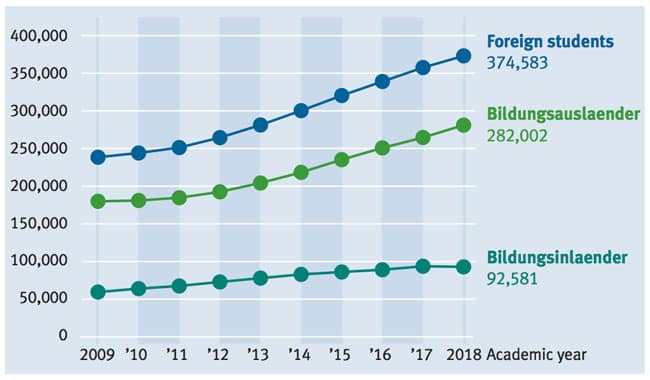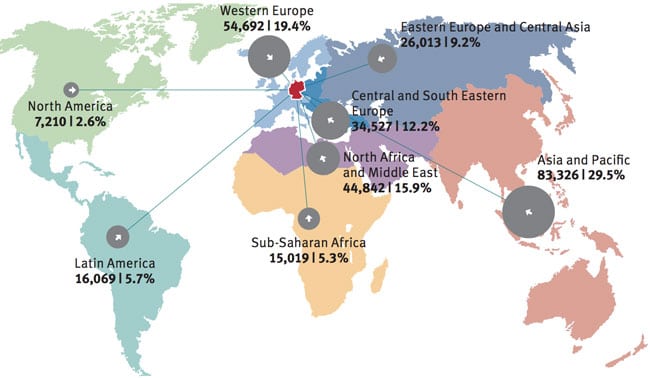Germany’s foreign enrolment grew again in 2018
An annual trends report from the German Academic Exchange Service (DAAD) shows that the number of international students in Germany has climbed once again, with 374,580 foreign students enrolled in German universities in 2018, up from 358,900 in 2017. This represents 4.4% growth, slightly less than the 5.5% growth the previous year. All of Germany’s top 10 sending markets grew in 2018 with the exception of Russia and France, which sent slightly fewer students. Syria made into the top 10 for the first time in 2018, while Ukraine dropped out.
Bildungsauslaender student numbers grow by 10%
DAAD differentiates between international students who have obtained their higher education entrance qualifications outside Germany (Bildungsauslaender) and those who obtained them within Germany (Bildungsinlaender). Bildungsauslaender thus more directly correlate with current demand trends for German higher education in other countries. Their numbers have been growing much more quickly than Bildungsinlaender since about 2013, and this trend continued in 2018.

Syria sends 69% more students and makes it into top 10 sending markets
Chinese students compose 13% of international students in German universities and there were 36,915 of them in 2018, up 5.5% over 2017. The Indian market – which contributes 6% of the international student population – grew by an impressive 13% from 2017 to 2018 to 17,295 students.
Rounding out Germany’s top 10 sending markets are Austria (11,130, up 5.5%), Russia (10,975, down 3%), Italy (8,910, up 4%), Syria (8,620, up 69%), Turkey (7,635, up 9.7%), Iran (7,530, up 6%), Cameroon (7,345, up 1%), and France (7,200, down 1.2%).

Germany remains one of the most popular study destinations
Germany remains one of the world’s most popular study destinations, in the company of the US, the UK, Australia, Canada, and China, and its recent 4.4% growth of international students in its universities keeps it very competitive. However, as we have noted often, the competition is vigorous right now for international students and multiple countries have achieved impressive recent growth. For example:
- 1,094,790 foreign students were enrolled in US higher education institutions in 2018, 1.5% more than in 2017
- Canada reported 16.3% growth in 2019, reaching 572,415 international students in its higher education institutions;
- Australia’s higher education providers hosted 350,470 foreign students in 2017, and in early-2018 had registered 12.8% growth compared with early-2017;
- 458,490 international students were enrolled in UK universities in 2018, representing growth of 4% over the previous year;
- China enrolled 492,186 international students in 2018 (not all in universities), up 1% over 2017.
For additional background please see:
















